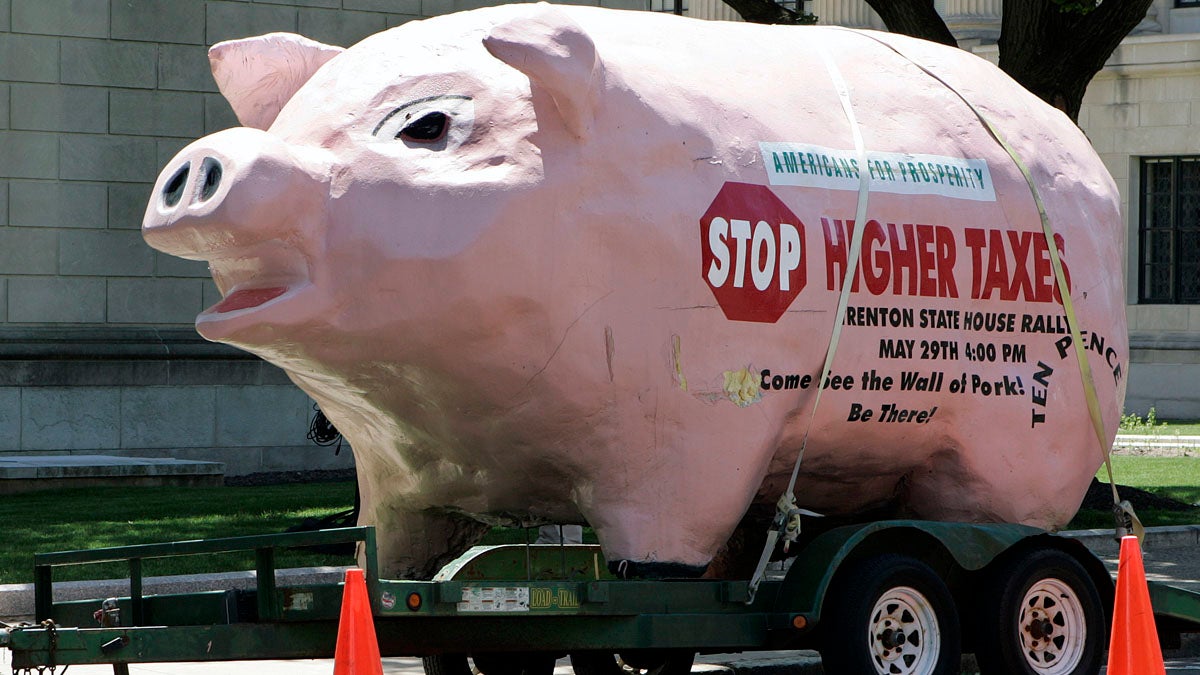Rutgers study casts doubt on how much New Jersey towns can save by merging
Listen
A pig parked next to the New Jersey Statehouse in Trenton expresses the sentiments of taxpayers in 2008 -- which has not changed since then. State officials say merging municipal services could help keep costs down.(AP file photo)
Rutgers analysis finds consolidating New Jersey towns would not produce significant property tax savings, even though Gov. Chris Christie and Senate President Steve Sweeney are both merger advocates.
· “Size May Not Be The Issue,” was released Monday (Nov. 17), concludes that rural communities with smaller populations often targeted for consolidation actually have the lowest municipal government service costs. The analysis is first is a series of studies focusing on “understanding the differences in costs among the municipalities and the extent to which consolidation, shared services or other strategies might be effective in controlling local government costs.”
· Study findings contradict “conventional wisdom” advocated by Christie and Sweeney (and many before him dating back to former Assembly Speaker Alan Karcher, who in 1989 wrote New Jersey’s Multiple Municipal Madness) that consolidation would produce property tax savings to lure new businesses and home buyers to NJ, and make living there more affordable for seniors and middle-income families.
· Study done by Raphael J. Caprio and Marc Pfeiffer at the Local Government Center at the Edward J. Bloustein School of Planning and Public Policy at Rutgers/ New Brunswick. The study analyzed municipal expenditures of 513 communities, excluding resort towns.
Study highlights:
· Previous studies that said smaller municipalities are cost-inefficient were skewed because they included resort (shore) municipalities, which have disproportionately higher costs — their year-round populations are low and they spend a lot on police and other services for tourists every summer.
· The wealthiest and poorest municipalities have the highest costs — affluent taxpayers are willing to pay for a higher level of services, and poor towns have a “greater need of poorer populations for more police protection and social services that are paid for primarily with state aid.”
· Highest cost: over $2,000 per person for municipal/government services, 50 percent more than the state average. Wealthiest municipalities: Harding, Alpine. Poorest: Newark, Camden, Trenton.
· In general, New Jersey residents get the level of municipal services they want.
· Sweeney is pushing for a “big stick” approach. He wants to force towns to adopt shared services or lose state aid.
· New Jersey ranks 34th in the nation in the number of general governments per capita.
· Study concludes too little attention has been paid to the largest cause of property tax increases — cuts in state aid to municipalities. e.g., from 2007-2009 state taxes rose from 51.7 percent to 58.3 percent of local municipal budget revenue to make up a $423.7 million deficit. Property taxes rose $1.36 billion during that time period.
· Study recommendations:
o Policymakers should stop buying into the “folk hypothesis” of “consolidating our way to savings” and focus on solutions such as analyzing the impact lf the 2011 pension and health benefits law, municipal budget cap laws, and to overhaul the interest arbitration statue for police and firefighters.
o Design need-based property tax relief programs to focus on senior citizens, lower-income property taxpayers.
o Create a blue ribbon panel to focus on tax property issues — overdue and needed again.
WHYY is your source for fact-based, in-depth journalism and information. As a nonprofit organization, we rely on financial support from readers like you. Please give today.

